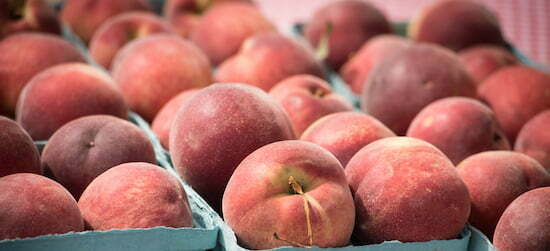We’re continuing our tips for preserving your end-of-summer farmers market bounty this week, even if you can’t get your hands on any canning equipment. (You can thank the COVID-19 combination of boredom and prepper mentality for a nationwide shortage.) This week we’re focusing on oven drying. For a guide to air drying, look for last week’s post on fromhere.org.
Oven drying works well for many vegetables and fruits in season now, including tomatoes, corn, okra, beets, summer squash, peaches, nectarines, figs, apples, and pears. Nighttime temperatures have started to drop, so keeping the oven on for several hours or overnight isn’t the unthinkable prospect it was a few weeks ago.
As a general method, you want to slice fruits and vegetables and place them on parchment-lined trays in a single layer, spaced to allow for airflow. Ideally, you want to dehydrate at 140 degrees, but most ovens don’t go that low, so use the lowest setting available. You can leave the oven door slightly ajar to keep the temperature down as well as allow condensation to escape. Directing a fan at an open oven can also increase airflow. But be mindful of these hacks, especially if you have kids or pets freely roaming the kitchen. The drying process will depend on airflow and temperature. It can take anywhere from a few hours to several days.
Because oven-drying isn’t quite as effective as using a food dehydrator, it’s safest to store your oven-dried products in the freezer. They’ll take up considerably less space than they would freshly frozen. For easiest reuse, freeze cooled dried vegetables on trays. Once frozen, you can move them to airtight freezer bags.
Small and medium tomatoes, such as paste, cocktail, or cherry types, are the best candidates for oven-drying. Slice them in half lengthwise and arrange them cut-side up on trays, spaced to allow airflow between them. Sprinkle lightly with salt. Monitor the trays in the oven to make sure they are drying evenly and the edges don’t get scorched. Dry until tomatoes are shriveled and rubbery.
Vegetables such as beets, okra, and summer squash can be sliced to ⅛- or ¼-inch disks. Wash and trim all vegetables first. Peel the beets. Briefly blanching helps to stop the enzyme process that causes color and flavor loss during storage. Dry until brittle. For corn, blanch whole cobs. Cut off the kernels and spread kernels on trays. Cobs can be dried separately and used for fire starter.
Fruits need to be pretreated to prevent darkening. There are several methods for this, such as using an ascorbic acid dip. Mix one teaspoon of powdered ascorbic acid in two cups of water. Soak fruit slices for 10 minutes. Apples and pears should be peeled, cored, and sliced in ⅛-inch rings. Peel peaches and nectarines, remove the pit, and cut into quarters or slices. Slice figs in half. Fruits should still be pliable after drying, but without moisture that can be squeezed out.
In addition to a plethora of late-summer produce, markets also have meats, eggs, bread, cheese, fermented products, baked goods, and beverages. Find more details about farms and markets throughout the region in ASAP’s online Local Food Guide.
Fresh at Farmers Markets This Week

